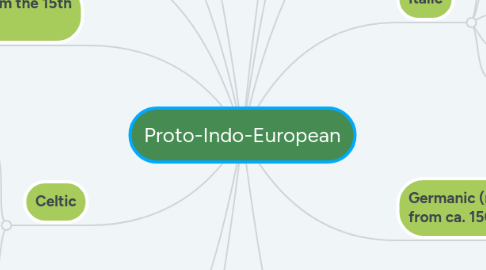
1. Indic ("Indo-Aryan")
1.1. Sanskrit (Vedic, transmitted orally from ca. 1200-1000 BCE; oldest written Sanskrit texts from the 2nd century CE; oldest written Indic texts (Prakit) from the 3rd century BCE)
2. Iranian
2.1. Avestan (the language of Zarathustra's teachings, orally transmitted from ca. 100 BCE; oldest written texts from the early centuries CE)
2.2. Old Persian (inscriptions of the great Persian kings, 6th-4th century BCE)
2.3. Middle Iranian: Middle Persian (Pahlavi), Sogdian, Khotanese Saka etc.
2.4. Modern Iranian: Persian, Kurdish, Pashto, Essetic, etc.
3. Anatolian
3.1. Hittite (17th-13th century BCE)
3.2. Palaic
3.3. Luwian (14th-13th century BCE)
3.4. Hieroglyphic Luwian (from 15th century BCE)
3.5. Lycian (5th-4th century BCE)
3.6. Lydian (7th-4th century BCE)
4. Tocharian (in China)
4.1. Tocharian A (8th-9th century CE)
4.2. Tocharian B (6th-9th century CE)
5. Armenian (attested from the 5th century CE)
6. Greek
6.1. Mycenaen in the 14th century BCE, inscriptions and literature from the 8th century BCE (Homer)
7. Albanian (attested from the 15th century CE)
8. Italic
8.1. Latin (from 7th century BCE)
8.2. Faliscan (3rd-2nd century BCE)
8.3. Oscan (from 6th century BCE)
8.4. Umbrian (from 7th century BCE)
8.5. Venetic (6th-1st century BCE)
9. Celtic
9.1. Continental Celtic
9.1.1. Gaulish (inscriptions from ca. 200 BCE to 200 CE)
9.1.2. Lepontic (North Italy; inscriptions from the 5th-1st century BCE)
9.1.3. Celtiberian (Spain; inscriptions from 2nd-1st century BCE)
9.2. Insular Celtic
9.2.1. Irish: Old Irish inscriptions from ca. 400, literature from the 7th century CE
9.2.2. Brittonic: Welsh (from 8th century), Breton (from 8th century), Cornish (9th-18th century)
9.2.2.1. Welsh (from 8th century)
9.2.2.2. Breton (from 8th century)
9.2.2.3. Cornish (9th-18th century)
10. Germanic (runic inscriptions from ca. 150 CE)
10.1. East Germanic
10.1.1. Gothic (Bible translation of Wulfila, 4th century CE)
10.2. North Germanic
10.2.1. Old Norse
10.2.2. Old Icelandic (runic inscriptions, literature from 13th century CE)
10.3. West Germanic
10.3.1. Old English (after ca. 700 CE)
10.3.2. Old High German (from 8th century CE)
10.3.3. Old Saxon (from 9th century CE)
11. Baltic
11.1. Old Prussian (14th-17th century CE)
11.2. Lithuanian
11.3. Latvian (from 16th century CE)
12. Slavic (Old Church Slavonic from 10th century CE)
12.1. East Slavic
12.1.1. Russian
12.1.2. Ukranian
12.1.3. Belarusian
12.2. West Slavic
12.2.1. Czech
12.2.2. Slovak
12.2.3. Polish
12.2.4. Upper Sorbian
12.2.5. Lower Sorbian
12.3. South Slavic
12.3.1. Serbian/Croatian/Bosnian/Montenegrin
12.3.2. Slovenian
12.3.3. Macedonian
12.3.4. Bulgarian
13. Other languages
13.1. Phrygian
13.1.1. Old Phrygian: inscriptions from the 8th-4th century BCE
13.1.2. New Phrygian, inscriptions from the 2nd-3rd century BE
